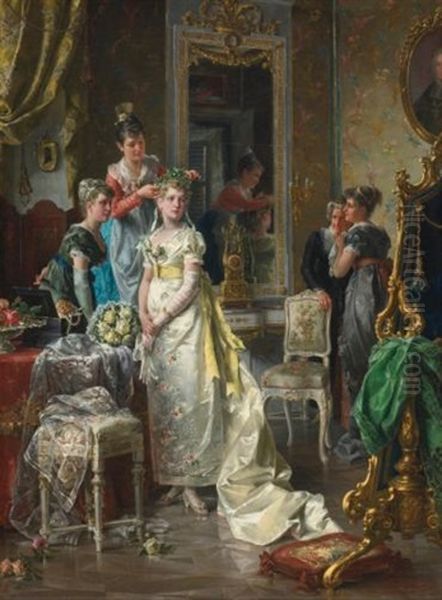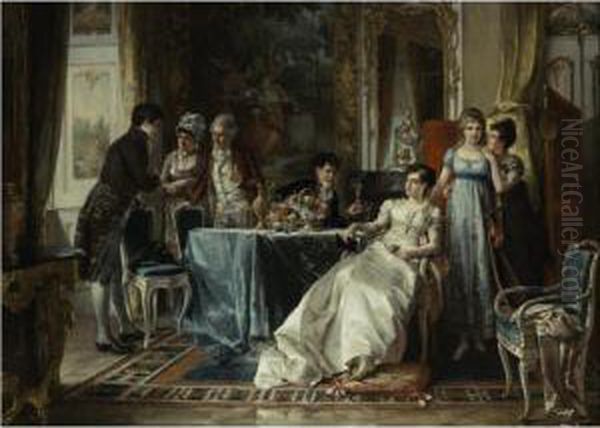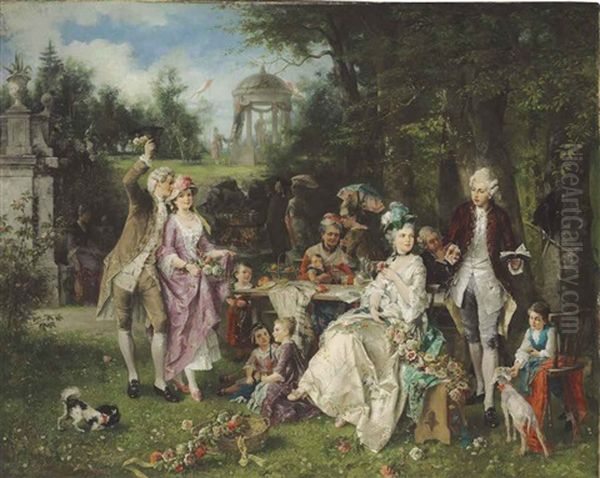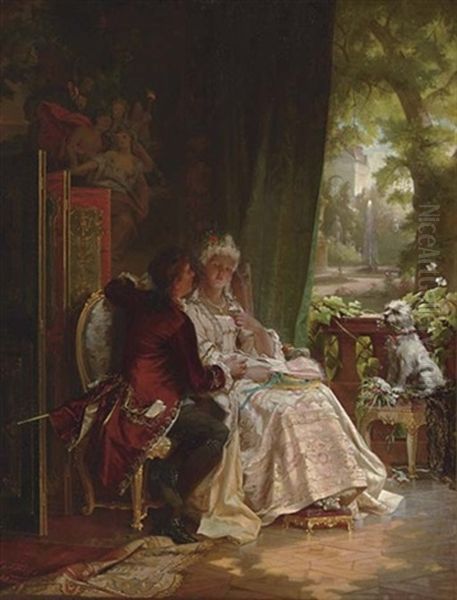Carl Herpfer, a distinguished German painter of the 19th century, carved a significant niche for himself through his exquisite depictions of bourgeois life, often imbued with the grace and charm reminiscent of the Rococo era. Born in 1836 and passing away in 1897, Herpfer's career spanned a period of considerable social and artistic transformation in Germany and across Europe. His works serve as a luminous window into the aspirations, social customs, and aesthetic preferences of the burgeoning middle and upper classes of his time, capturing moments of leisure, romance, and refined social interaction with remarkable sensitivity and technical skill.
The Artistic Landscape of Herpfer's Germany
To fully appreciate Carl Herpfer's contribution, it is essential to consider the artistic environment in which he flourished. The 19th century in Germany was a period of dynamic artistic development, with cities like Munich and Düsseldorf emerging as major art centers. The Munich School, in particular, became renowned for its genre painting, historical subjects, and a commitment to realism, though often tinged with romantic or anecdotal elements. Artists such as Carl Spitzweg, with his charming and often humorous portrayals of everyday life, and Franz von Defregger, known for his scenes from Tyrolean peasant life and history, were prominent figures.
The taste of the era was heavily influenced by the rising bourgeoisie, who sought art that reflected their own lives, values, and growing prosperity. This created a fertile ground for genre painting – scenes of everyday life – which Herpfer embraced with distinction. Unlike the grand historical or mythological themes favored by earlier academic traditions, or the stark social realism that would emerge later, Herpfer's art offered an idealized yet recognizable vision of contemporary comfort and elegance. His approach can be seen as part of a broader European trend, where artists like Jean Béraud and James Tissot in France and England were similarly capturing the fashionable life of their respective societies.
Stylistic Hallmarks and Rococo Affinities

Carl Herpfer's style is characterized by meticulous attention to detail, a refined color palette, and an elegant compositional sense. He possessed a remarkable ability to render the textures of luxurious fabrics – the sheen of silk, the richness of velvet, the delicacy of lace – which played a crucial role in conveying the status and sophistication of his subjects. This focus on material splendor was often coupled with a soft, atmospheric light that enhanced the romantic and intimate quality of his scenes.
A distinctive feature of Herpfer's work is its affinity with the Rococo period of the 18th century. While firmly a 19th-century painter, he often evoked the spirit of artists like Jean-Antoine Watteau, François Boucher, and Jean-Honoré Fragonard. This Rococo revival sentiment manifested in his choice of themes – courtship, garden parties, musical interludes, and intimate domestic moments – as well as in the graceful poses of his figures and the overall decorative charm of his compositions. However, Herpfer's Rococo was filtered through a Victorian sensibility, often imbued with a greater sense of propriety and domesticity than its more overtly playful 18th-century predecessor.
His figures are typically portrayed with a sense of poise and quiet emotion. He was adept at capturing subtle psychological nuances, whether the tender anticipation of a bride, the focused concentration of chess players, or the convivial spirit of a social gathering. This ability to combine decorative elegance with emotional resonance contributed significantly to the appeal of his paintings.
Key Themes in Herpfer's Oeuvre
Herpfer's body of work explores several recurring themes, each offering insight into the social fabric and cultural values of his time.
Scenes of Courtship and Romance
Many of Herpfer's most celebrated paintings delve into the rituals of courtship and marriage, subjects of immense importance in 19th-century society. These works often depict tender moments, filled with anticipation and societal expectations. The Bride, for instance, captures a young woman in her wedding attire, likely on the cusp of a life-altering event. The painting would have resonated deeply with contemporary audiences, for whom marriage was a cornerstone of social order and personal aspiration.
Another work, The Suitor Meets Her Family, vividly portrays a significant step in the courtship process. Such scenes were popular as they reflected the structured social interactions surrounding marriage proposals and family approvals. Herpfer’s skill in rendering the expressions and postures of the figures would convey the mix of formality, hope, and perhaps a touch of anxiety inherent in such occasions. These paintings not only showcased his artistic talent but also served as visual narratives of societal norms.
Leisure, Social Gatherings, and Domesticity

Herpfer excelled in depicting the leisured pursuits and social engagements of the affluent. The Picnic, dated 1869, is a prime example, presenting an idyllic outdoor gathering. Such scenes of al fresco dining and socializing were popular, symbolizing a harmonious blend of nature and refined society. The careful arrangement of figures, the depiction of fashionable attire, and the overall atmosphere of relaxed elegance are characteristic of Herpfer's approach to this theme.
Indoor scenes of domestic life and social entertainment also feature prominently. Woman Attending a Masquerade Ball hints at the more festive and perhaps mysterious side of social life, where identities could be playfully concealed, and a different kind of social interaction could unfold. The allure of the masquerade, with its potential for romance and intrigue, was a recurring motif in 19th-century art and literature.
Happiness (Glück), an 1869 oil on canvas, further illustrates his focus on intimate domestic settings. The title itself suggests a focus on personal contentment and the comforts of home. Often, these interiors are richly appointed, with details like ornate furniture, plush carpets, and decorative objects contributing to the overall sense of prosperity and taste. The inclusion of a fireplace, as noted in the description of Happiness, often symbolized warmth, hearth, and the heart of the home, creating a timeless sense of comfort.
The Intellectual Pastime: The Chess Game
A particularly notable work is The Chess Players, painted in 1887. This painting, first exhibited in Munich, moves beyond purely social or romantic themes to explore an intellectual pursuit. Chess games in art often carry symbolic weight, representing strategy, intellect, and sometimes the subtle dynamics of human relationships. Herpfer’s rendition likely focused on the concentration of the players and the quiet drama of the game, capturing the "emotional and symbolic meaning" inherent in such a contest. This subject was also tackled by other artists, such as Honoré Daumier in a more caricatural style, or with more dramatic intensity by painters like Sir John Lavery. Herpfer's version would likely align with his characteristic elegance and refined observation.
A Closer Look at Representative Works
Several of Carl Herpfer's paintings have garnered particular attention, either through exhibitions, sales, or their representative quality.

The Bride: This painting stands as a quintessential example of Herpfer's focus on significant life moments within the bourgeois milieu. The depiction of the bride, likely adorned in intricate lace and silk, would have allowed Herpfer to showcase his mastery in rendering textures. The emotional weight of the moment – a blend of joy, nervousness, and hope – would be subtly conveyed through her posture and expression. While the provided information notes a discussion around this painting in the context of art market phenomena (specifically regarding reproductions, not the authenticity of Herpfer's original), the work itself remains a testament to his thematic concerns.
The Chess Players (1887): Exhibited in Munich, this work highlights Herpfer's versatility in capturing different facets of social life. Beyond mere entertainment, a chess game in a 19th-century setting often implied education, leisure, and a certain level of intellectual engagement. Herpfer would have focused on the intense concentration of the players, the quiet atmosphere of the room, and perhaps the subtle interplay of personalities across the board. The setting, likely a well-appointed interior, would further underscore the comfortable lifestyle of the subjects.
The Picnic (1869): Measuring an impressive 117.4 x 147.3 cm, this painting, once exhibited at Christie's in New York (2013), exemplifies the popular 19th-century theme of outdoor leisure. Herpfer would have orchestrated a scene of relaxed elegance, with figures in fashionable attire enjoying food and conversation in an idyllic landscape. Such paintings celebrated the newfound ability of the middle and upper classes to enjoy leisure time and appreciate the beauty of nature, albeit in a cultivated and socially structured manner. The scale of the work suggests it was a significant commission or a piece intended for prominent display.
Happiness (Glück) (1869): This oil on canvas, measuring 84.05 x 90.5 cm and auctioned at Hampel in Munich in 2012, encapsulates the ideal of domestic bliss. The title itself directs the viewer's interpretation towards a scene of contentment and tranquility. The description mentioning the integration of fireplace light suggests a warm, intimate atmosphere, a sanctuary from the outside world. Herpfer's skill would lie in creating a harmonious composition that visually embodies this sense of well-being, likely through the depiction of a comfortable interior and figures at ease.
Woman Attending a Masquerade Ball: This title suggests a work capturing the excitement and anonymity of a popular 19th-century social event. The masquerade offered a temporary escape from strict social conventions, allowing for a degree of freedom and intrigue. Herpfer would have likely focused on the elegance of the costume, the mystery of the masked figure, and the vibrant atmosphere of the ball. Such a scene provided ample opportunity to depict rich fabrics, elaborate hairstyles, and the dynamic interplay of figures in a festive setting.

The Suitor Meets Her Family: This painting addresses a critical ritual in Victorian-era courtship. The scene would be charged with social significance, representing the formal process of seeking a hand in marriage. Herpfer’s portrayal would likely emphasize the decorum of the occasion, the distinct roles of the family members, and the suitor's hopeful yet respectful demeanor. The interior setting would be meticulously rendered, reflecting the family's social standing and taste.
Herpfer in the Context of His Contemporaries
While specific records of Carl Herpfer's direct collaborations or rivalries with other artists are not extensively detailed in the provided information, he operated within a rich artistic ecosystem. His focus on genre scenes places him in dialogue with other German artists like Ludwig Knaus, who was highly acclaimed for his sentimental and anecdotal depictions of peasant and bourgeois life. Knaus, like Herpfer, had a keen eye for detail and narrative.
Internationally, Herpfer's work can be compared to that of Belgian artists such as Alfred Stevens, who was renowned for his elegant portrayals of fashionable Parisian women in luxurious interiors. Stevens, too, had an extraordinary ability to capture the textures of fabrics and the nuances of contemporary high society. In France, artists like Gustave Léonard de Jonghe also specialized in similar refined genre scenes.
The meticulous finish and attention to detail in Herpfer's paintings also align with broader academic traditions prevalent in the 19th century, even if his subject matter was more intimate. Masters of the French Academy like Jean-Léon Gérôme or William-Adolphe Bouguereau, though often tackling historical, mythological, or orientalist themes, shared a commitment to polished surfaces and precise rendering that was highly valued at the time. Herpfer applied this dedication to technical excellence to his chosen sphere of bourgeois life.
Exhibition History and Art Market Reception
Carl Herpfer's works were exhibited during his lifetime and continue to appear in the art market, attesting to their enduring appeal. The 1887 exhibition of The Chess Players in Munich indicates his participation in the established art venues of his day. Munich, as a leading art center, would have provided significant exposure.

In more recent times, his paintings have featured in prominent auction houses. The Picnic was offered at Christie's in New York in 2013, and Happiness was sold at Hampel Fine Art Auctions in Munich in 2012. The appearance of his works in such sales reflects a continued collector interest in 19th-century European genre painting. The provenance note for The Picnic, mentioning it was "acquired from the above by the present owner," suggests its passage through private collections, which is typical for many artists of this genre.
The provided information also touches upon a nuanced aspect of art market perception, referencing a discussion involving The Bride in the context of "counterfeit art market phenomena." It's important to clarify that this does not imply Herpfer's work itself was a forgery, but rather that its style or subject matter might have been popular enough to inspire reproductions or become entangled in broader discussions about authenticity and value in the art market. This, in a way, can underscore the desirability of the type of art Herpfer produced. His works, with their accessible charm and technical finesse, appealed to a wide audience.
The Legacy of Carl Herpfer
Carl Herpfer may not be as universally recognized as some of the leading avant-garde figures of the 19th century who broke radically with tradition, such as the Impressionists. However, his contribution lies in his masterful ability to capture and idealize a specific segment of society during a particular historical period. He was a skilled chronicler of the 19th-century bourgeois world, preserving its customs, aesthetics, and aspirations with elegance and sensitivity.
His paintings offer valuable insights into the social history of the era, particularly concerning family life, courtship rituals, leisure activities, and the material culture of the affluent classes. The romanticized yet detailed portrayal of these aspects provides a visual counterpart to the literature and social commentaries of the time. Artists like Herpfer fulfilled an important role, creating works that were both aesthetically pleasing and reflective of their patrons' self-image and ideals.
The enduring appeal of his work lies in its combination of technical proficiency, charming subject matter, and the nostalgic glimpse it offers into a bygone era of perceived elegance and order. While specific details about his personal life, such as his exact birthplace, death place, or private anecdotes, remain less documented in readily available sources, his artistic legacy is clearly defined by the canvases he left behind. These paintings continue to be appreciated by collectors and art enthusiasts for their beauty, craftsmanship, and the gentle, refined world they so skillfully evoke. Carl Herpfer remains a noteworthy figure in the rich tapestry of 19th-century German art.